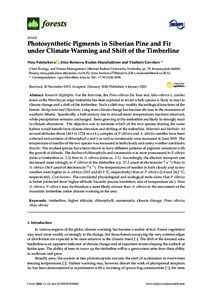Показать сокращенную информацию
Photosynthetic Pigments in Siberian Pine and Fir under ClimateWarming and Shift of the Timberline
| Автор | Pakharkova, N. V. | |
| Автор | Borisova, I. V. | |
| Автор | Sharafutdinov, R. A. | |
| Автор | Gavrikov, V. L. | |
| Дата внесения | 2021-08-13T09:35:09Z | |
| Дата, когда ресурс стал доступен | 2021-08-13T09:35:09Z | |
| Дата публикации | 2020-01 | |
| Библиографическое описание | Pakharkova, N. V. Photosynthetic Pigments in Siberian Pine and Fir under ClimateWarming and Shift of the Timberline [Текст] / N. V. Pakharkova, I. V. Borisova, R. A. Sharafutdinov, V. L. Gavrikov // Forests. — 2020. — Т. 11 (№ 1). — С. 63 | |
| ISSN | 19994907 | |
| URI (для ссылок/цитирований) | https://www.mdpi.com/1999-4907/11/1/63 | |
| URI (для ссылок/цитирований) | https://elib.sfu-kras.ru/handle/2311/143163 | |
| Аннотация | Research Highlights: For the first time, the Pinus sibirica Du Tour and Abies sibirica L. conifer forest at theWest Sayan ridge timberline has been explored to reveal which species is likely to react to climate change and a shift of the timberline. Such a shift may modify the ecological functions of the forests. Background and Objectives: Long-term climate change has become obvious in the mountains of southern Siberia. Specifically, a half-century rise in annual mean temperatures has been observed, while precipitation remains unchanged. Trees growing at the timberline are likely to strongly react to climate alterations. The objective was to estimate which of the two species sharing the same habitat would benefit from climate alteration and shifting of the timberline. Materials and Methods: At several altitudes (from 1413 to 1724 m a.s.l.), samples of P. sibirica and A. sibirica needles have been collected and contents of chlorophyll a and b as well as carotenoids were measured in June 2019. The temperature of needles of the two species was measured in both cloudy and sunny weather conditions. Results: The studied species have been shown to have di erent patterns of pigment variations with the growth of altitude. The decline of chlorophylls and carotenoids was more pronounced in P. sibirica (ratio at timberline ca. 2.2) than in A. sibirica (ratio ca. 3.1). Accordingly, the electron transport rate decreased more strongly in P. sibirica at the timberline (ca. 37.2 mol of electrons/m2 s1) than in A. sibirica (56.9 mol of electrons/m2 s1). The temperatures of needles in both cloudy and sunny weather were higher in A. sibirica (10.5 and 43.3 C, respectively) than in P. sibirica (3.8 and 24.2 C, respectively). Conclusions: The considered physiological and ecological traits show that P. sibirica is better protected from higher-altitude hazards (excess insolation, rise of temperature etc.) than A. sibirica. P. sibirica may be therefore a more likely winner than A. sibirica in the movement of the mountain timberline under climate warming in the area. | |
| Тема | timberline | |
| Тема | higher altitude | |
| Тема | chlorophyll | |
| Тема | carotenoids | |
| Тема | climate change | |
| Тема | Pinus sibirica | |
| Тема | Abies sibirica | |
| Название | Photosynthetic Pigments in Siberian Pine and Fir under ClimateWarming and Shift of the Timberline | |
| Тип | Journal Article | |
| Тип | Published Journal Article | |
| Страницы | 63 | |
| Дата обновления | 2021-08-13T09:35:09Z | |
| DOI | 10.3390/f11010063 | |
| Институт | Институт экологии и географии | |
| Подразделение | Кафедра экологии и природопользования | |
| Журнал | Forests | |
| Квартиль журнала в Scopus | Q1 | |
| Квартиль журнала в Web of Science | Q1 |

